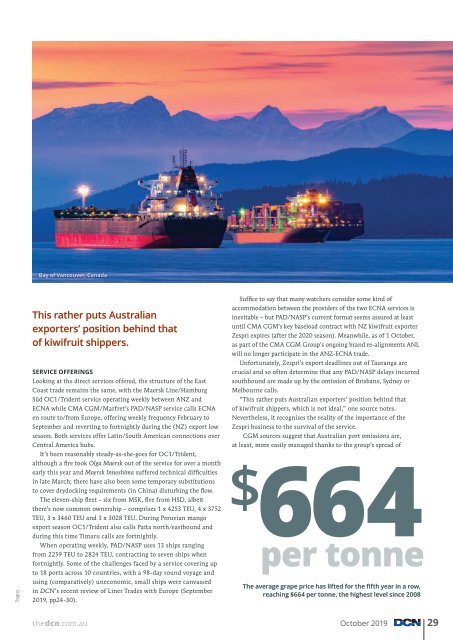DCN October Edition 2019
You also want an ePaper? Increase the reach of your titles
YUMPU automatically turns print PDFs into web optimized ePapers that Google loves.
Bay of Vancouver, Canada<br />
Ssguy<br />
This rather puts Australian<br />
exporters’ position behind that<br />
of kiwifruit shippers.<br />
SERVICE OFFERINGS<br />
Looking at the direct services offered, the structure of the East<br />
Coast trade remains the same, with the Maersk Line/Hamburg<br />
Süd OC1/Trident service operating weekly between ANZ and<br />
ECNA while CMA CGM/Marfret’s PAD/NASP service calls ECNA<br />
en route to/from Europe, offering weekly frequency February to<br />
September and reverting to fortnightly during the (NZ) export low<br />
season. Both services offer Latin/South American connections over<br />
Central America hubs.<br />
It’s been reasonably steady-as-she-goes for OC1/Trident,<br />
although a fire took Olga Maersk out of the service for over a month<br />
early this year and Maersk Innoshima suffered technical difficulties<br />
in late March; there have also been some temporary substitutions<br />
to cover drydocking requirements (in China) disturbing the flow.<br />
The eleven-ship fleet – six from MSK, five from HSD, albeit<br />
there’s now common ownership – comprises 1 x 4253 TEU, 4 x 3752<br />
TEU, 3 x 3460 TEU and 3 x 3028 TEU. During Peruvian mango<br />
export season OC1/Trident also calls Paita north/eastbound and<br />
during this time Timaru calls are fortnightly.<br />
When operating weekly, PAD/NASP uses 13 ships ranging<br />
from 2259 TEU to 2824 TEU, contracting to seven ships when<br />
fortnightly. Some of the challenges faced by a service covering up<br />
to 18 ports across 10 countries, with a 98-day round voyage and<br />
using (comparatively) uneconomic, small ships were canvassed<br />
in <strong>DCN</strong>’s recent review of Liner Trades with Europe (September<br />
<strong>2019</strong>, pp24-30).<br />
Suffice to say that many watchers consider some kind of<br />
accommodation between the providers of the two ECNA services is<br />
inevitable – but PAD/NASP’s current format seems assured at least<br />
until CMA CGM’s key baseload contract with NZ kiwifruit exporter<br />
Zespri expires (after the 2020 season). Meanwhile, as of 1 <strong>October</strong>,<br />
as part of the CMA CGM Group’s ongoing brand re-alignments ANL<br />
will no longer participate in the ANZ-ECNA trade.<br />
Unfortunately, Zespri’s export deadlines out of Tauranga are<br />
crucial and so often determine that any PAD/NASP delays incurred<br />
southbound are made up by the omission of Brisbane, Sydney or<br />
Melbourne calls.<br />
“This rather puts Australian exporters’ position behind that<br />
of kiwifruit shippers, which is not ideal,” one source notes.<br />
Nevertheless, it recognises the reality of the importance of the<br />
Zespri business to the survival of the service.<br />
CGM sources suggest that Australian port omissions are,<br />
$<br />
at least, more easily managed thanks to the group’s spread of<br />
664<br />
per tonne<br />
The average grape price has lifted for the fifth year in a row,<br />
reaching $664 per tonne, the highest level since 2008<br />
thedcn.com.au <strong>October</strong> <strong>2019</strong> 29
















